Stephen George Foster
Family
Stephen George Foster was born in Dartmouth in 1897. He was the only son of George Hannaford Foster and his wife Florence Jolliffe.
George came from Kingswear, where his father, John Foster, had worked as a Platelayer on the railway. At the time of the 1891 Census, George lived with his family in Brixham Road, and worked as a parcel delivery boy.
George married Florence in 1895. She was one of several daughters of Edward Jolliffe and his wife Elizabeth Asquith. She was born in Plymouth, but her family had come to Dartmouth soon after, where her father worked as a packer at the Dartmouth factory of the Torbay & Dart Paint Company. In 1881, the family lived in Clarence Street. By the time of the 1891 Census, Florence, now aged 18, was at work too, in domestic service. She was the "general servant" for Miss Georgina Gibbs, who lived in Ridge Hill, Dartmouth.
After they married, George and Florence settled in Dartmouth. Stephen was born in 1897 and his sister Marjorie Gertrude in 1899. The 1901 Census recorded the family living in Mariners Place. By this time George had obtained work as a member of the civilian staff of HMS Britannia, where he was a Cadet servant. (Although work on the site for the new Royal Naval College began in 1898, the foundation stone was not laid until 1902 and the College was not opened until 1905.) By 1911, the family had moved to Duke Street. George still worked at the Royal Naval College, as a servant in the Cadet mess. Stephen, aged 14, and Marjorie, aged 12, were both at school.
Service
Unusually, Stephen's Army service papers are amongst those to have survived, and, though partly damaged and in some places, difficult to read, include details of his service and the circumstances of his death.
Stephen enlisted at Dartmouth on 23rd February 2016. He had just turned 19, and lived at 3 Church Road, Townstal, with his parents and sister. He was a Waterman, and for this reason, was recruited into the Inland Water Transport department of the Royal Engineers.
The use of the canal and river systems of France and Belgium had not been part of the Army's logistics and supply planning in the early part of the war. However, with the beginning of trench warfare, and the commitment to a large British army on the Western Front, the value of the inland water system to move supplies became more apparent. When it also became apparent that Belgian and French civilians were unlikely to provide sufficient or suitable manpower (typically whole families lived on their barges) the nascent Inland Water Transport department began to recruit experienced men from the necessary trades in Britain (and later, elsewhere) into the Royal Engineers.
Between January to September 1915, the department expanded from "one tug and thirty-four hired barges" to control a fleet of 270 vessels. The scope of the network expanded in parallel; at first only the northern waterways connecting Calais, Dunkirk, Armentieres and Bethune were used, but in the summer of 1915, it was extended to the Somme; in September 1916 to the Seine; and in July 1917, to the River Scarpe, which was reopened to navigation between Arras and Fampoux. In addition, there was eventually a coastal service between Dunkirk and Le Havre, which enabled a connection to be made between the different river systems, and a cross-channel service; due to congestion at Dover, a new depot and base was built at Richborough, Kent, involving the construction of a train ferry port.
The tonnage moved increased from just under 200,000 tons in 1915, to over 2,800,000 tons in 1918. Many different types of craft were in use. The service carried supplies such as forage, timber, building material for roads and railways, trench material, and ammunication; other branches of the work were carriage of the wounded in ambulance barges; and supply of drinking water. The service also built and repaired waterways and wharves, and repaired and maintained the craft. In 1916 and 1917, a large amount of pumping and filtration work was done to deal with inundation and drainage.
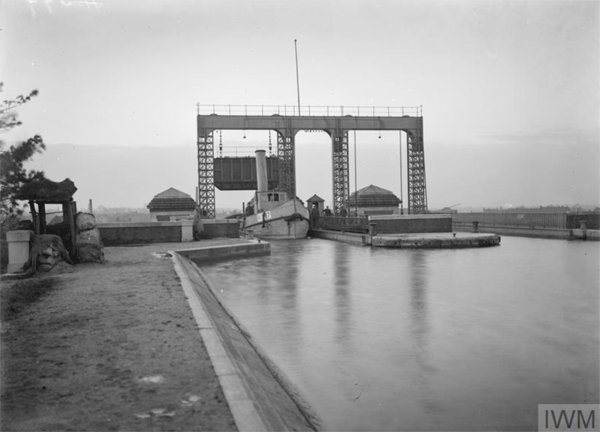
St Omer, France
© IWM (Q 35674)
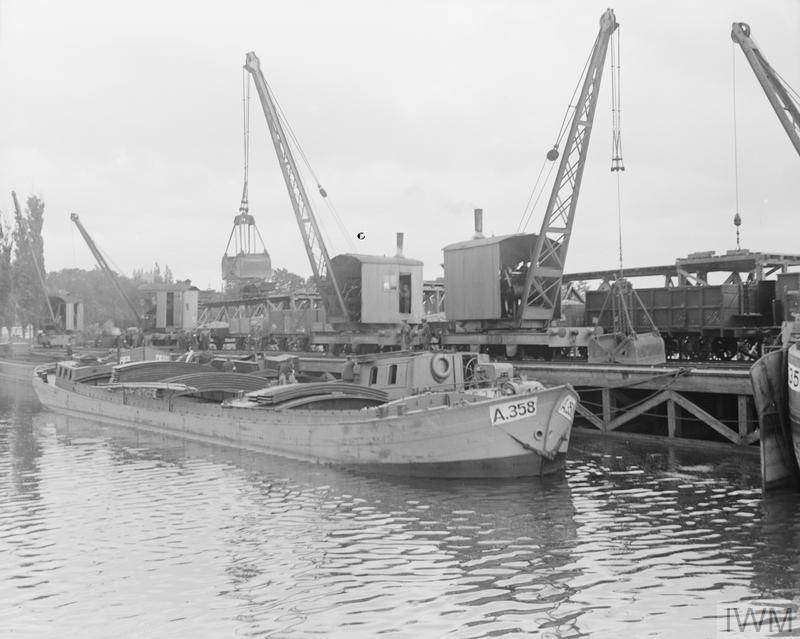
© IWM (Q 5920)
As part of a wider recruitment campaign, the Inland Water Transport came to Dartmouth to recruit men in February 1916. On 18th February 1916, the Dartmouth Chronicle reported:
Fourteen men left Dartmouth on Wednesday morning for service in the Inland Water Transport section of the Royal Engineers. They included nine Dartmouth men, one from Kingswear, and one from Blackawton. It is probable that twenty other recruits will leave tomorrow (Saturday). Others will take their departure next week, the total number of men already enlisted at Dartmouth this week for the Inland Water Transport being thirty-nine.
The newspaper published a list of recruits, including Stephen, and also William Henry Dodd and Charles Henry Gilbert, both of whom are on our database (and both of whom died after the Armistice).
The pay was good - up to 3s 2d per day; recruits were to be between the ages of 19 and 40, but in certain trades and specialisms, older men were accepted. Recruitment advertisements declared that men were "not required to go into the trenches in France although they will be given a certain amount of military training before being sent to their work". Evidently Stephen, and others, found this an attractive proposition.
For his training, Stephen went first to Longmoor Military Camp, in Hampshire. He then served in the UK until 4th August 1917 - unfortunately, the army form giving details of his service at home is damaged, so where he served is not known. However, it is clear that he went to France on 5th August 1917, and by 19th August, two weeks later, was at St Omer, an important centre for the Inland Water Transport in France.
Death
On the morning of 20th August 1917, Stephen disappeared. The following day, his body was found in the river. A Court of Enquiry was immediately convened and a report of the proceedings was included in Stephen's service papers. The evidence of Stephen's colleagues provides a glimpse of everyday life for members of the Inland Water Transport, housed on Barrack Barge A198 at St Omer - and also tells us a little more about Stephen:
Proceedings of a Court of Enquiry assembled at St Omer on the 21st August by order of D[irector], IWT, for the purpose of investigating the circumstances under which No. 150288 Sapper Foster RE IWT met his death on 20th August 1917.
Members: Lieut F Smith RE IWT; 2 Lieut A Lilwall RE IWT
The Court, having assembled pursuant to order, proceed to take evidence.
Answer: 4 or 5 years previous to the war
Answer: No, perfectly happy.
Answer: No sir, I only saw him leave the table.
Answer: Yes, excepting his cap.
Answer: No, he was a very quiet inoffensive lad, as far as I can say.
Answer: He told me he was shortsighted and nearly blind in one eye.
E A Burke, Lt Col RAMC, OC 10 Stationary Hospital
The verdict reached by the enquiry was that:
The Court having considered the evidence are of opinion that No 150288 Sapper Foster RE IWT met his death accidentally by drowning on the morning of 20th August 1917, but there is no evidence to shew how he came to be in the water.
Stephen had undergone a medical examination when joining the IWT. The form completed by the doctor at the time records that he suffered from "internal strabismus" in his left eye - that is, when one eye turns inwards relative to the other - but his vision was assessed as satisfactory at the time. It is interesting that though he had worked as a waterman in Dartmouth before joining, he could not swim.
Stephen was buried in Longuenesse Cemetery, at St Omer. He had been in France for only two weeks.
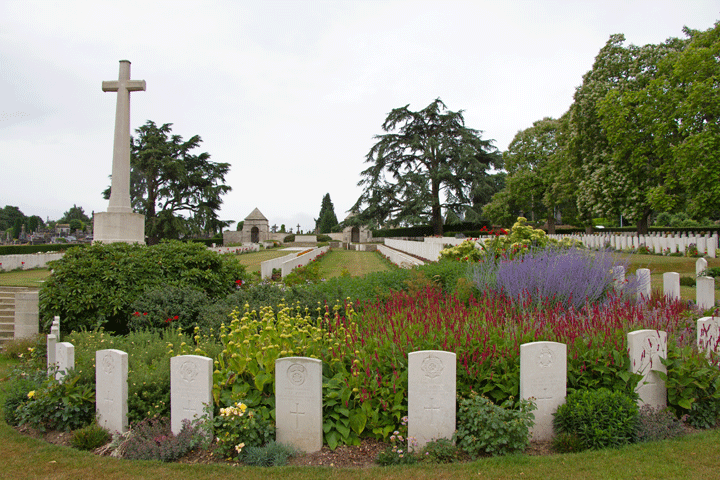
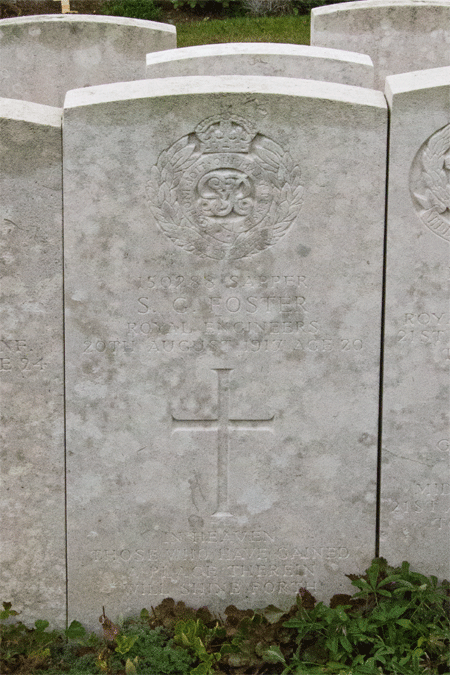
His mother, Florence, had his headstone engraved with the words: "In heaven those who have gained a place therein will shine forth".
News of his death quickly reached George and Florence in Dartmouth. A brief announcement appeared in the Chronicle of 31st August 1917:
Foster - In France, on August 21st (accidental), from submersion, Stephen G Foster, age 20.
Oddly, there seems to have been some confusion about the date recorded for Stephen's death. The Commonwealth War Graves Commission Graves Registration Report of 1920 recorded his date of death as 21st August 1917; and, as shown above, this was the date announced by the family. However, Stephen's service papers clearly show the date of death as 20th August 1917, and the latter was the date engraved on his headstone.
Commemoration
Stephen is commemorated in Dartmouth on the Town War Memorial and on the St Petrox Memorial Board. It will be seen that the St Petrox memorial records that he was "killed in action" (which clearly is incorrect) and that his date of death was 21st, rather than 20th August 1917.
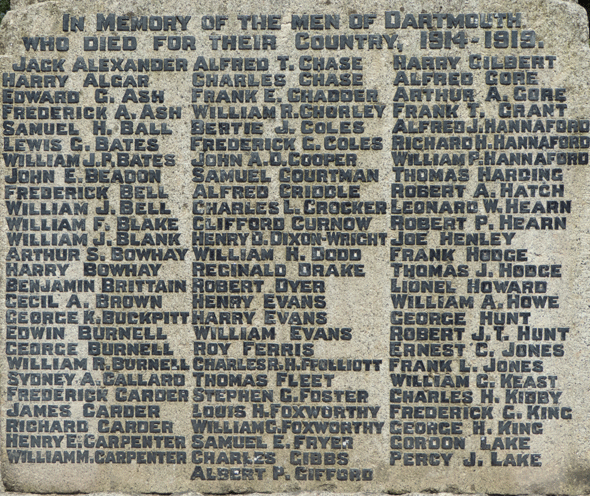
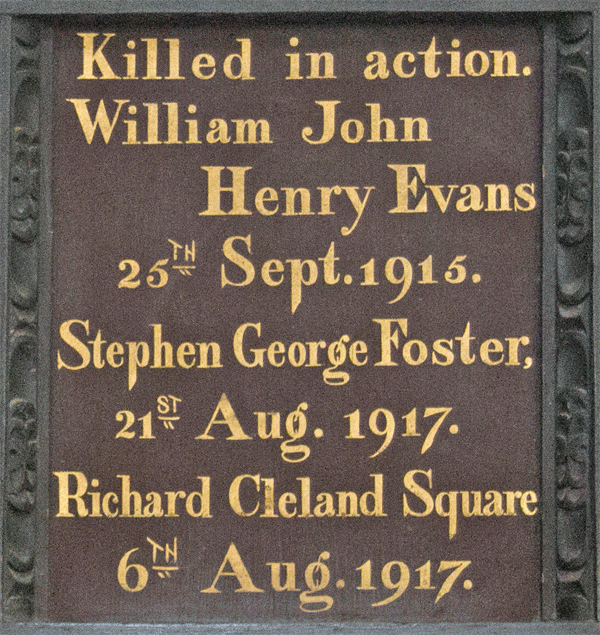
Sources
Stephen's service papers are held by the National Achives and are accessible through subscription websites.
Logistics and the BEF: The Development of Waterborne Transport on the Western Front, 1914-1916, Christopher Phillips, 2016, British Journal for Military History, Volume 2 no 2
The other citizen soldiers: recruiting technical experts on the Western Front, by Christopher Phillips
Imperial War Museum Collection
- http://www.iwm.org.uk/collections/item/object/205237980
- http://www.iwm.org.uk/collections/item/object/205270384
Information Held on Database
| Surname: | Foster |
| Forenames: | Stephen George |
| Rank: | Sapper |
| Service Number: | 150288 |
| Military Unit: | Inland Water Transport, Royal Engineers |
| Date of Death: | 20 Aug 1917 |
| Age at Death: | 20 |
| Cause of Death: | Accidental drowning |
| Action Resulting in Death: | |
| Place of Death: | St Omer, France |
| Place of Burial: | Buried St Omer Cemetery, France |
| Born or Lived in Dartmouth? | Yes |
| On Dartmouth War Memorial? | Yes |
| On St Saviour's Memorials? | No |
| On St Petrox Memorials? | Yes |
| On Flavel Church Memorials? | No |
| In Longcross Cemetery? | No |
| In St Clement's Churchyard? | No |
| On a Private Memorial? | No |
| On Another Memorial? | No |















